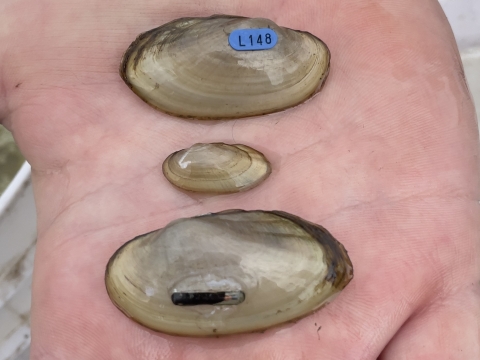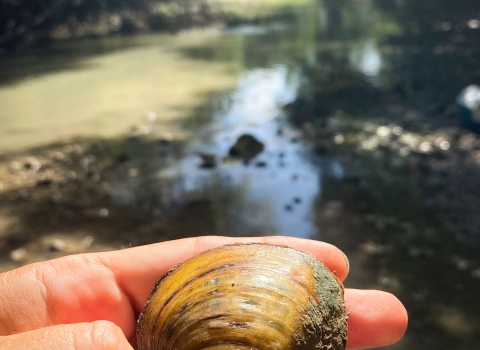In May, the San Antonio River Authority and U.S. Fish and Wildlife Service released freshwater mussels raised by Inks Dam National Fish Hatchery into the Mission Reach of the San Antonio River just south of downtown San Antonio. This historic event marked the first time hatchery-produced freshwater mussels have ever been reintroduced into the wild in Texas.
“As stewards of the San Antonio River Basin, the River Authority recognizes the importance of conserving and restoring freshwater mussel populations for the benefit of both our environment and our communities,” said Jim Campbell, San Antonio River Authority Chairman of the Board. “Through collaboration with national organizations like the U.S. Fish and Wildlife Service we are able to pioneer scientific research and conservation efforts that will help safeguard the natural heritage of our region.”
“This is an exciting milestone that’s been a few years in the making,” said Amy Lueders, the Service’s Southwest Regional Director. “Freshwater mussels are really challenging to propagate. They take a lot of work and innovation, and certainly there was a lot of innovation and persistence from both the Inks Dam National Fish Hatchery and the biologists at the San Antonio River Authority. We look forward to learning a lot and building on this success.”
The yellow sandshell mussels were grown at Inks Dam National Fish Hatchery in Burnet, Texas through a contract established with the San Antonio River Authority and U.S. Fish and Wildlife Service in 2019. Like other national fish hatcheries across the country, the mission at Inks Dam is to both improve recreational fishing and restore aquatic species that are in decline, at risk, and important to the health of our aquatic systems. The freshwater mussel propagation program at Inks Dam represents a relatively new facet of this mission and has evolved rapidly since its initiation in 2017.
Next, Inks Dam National Fish Hatchery hopes to transfer juveniles of three more contract mussel species, including pistolgrip, pimpleback, and threeridge, to the San Antonio River Authority for reintroduction to the Mission Reach. Propagated juvenile pistolgrip currently growing at Inks Dam have reached developmental milestones and could be ready for reintroduction to the San Antonio River as early as this summer.
Freshwater mussels help maintain healthy aquatic ecosystems because they are one of nature’s greatest natural filtration systems. In addition to protecting and improving water quality, they can also help stabilize the banks of rivers during high flow events.
“They burrow into the substrate, and they filter the water and can clean the water,” said Austin Davis, Senior Aquatic Biologist with the San Antonio River Authority. “That’s why we’re happy to have them here. It’s a good sign of high-quality habitat and high-quality water here in the Mission Reach.”
Like other mussel species across the country, Bexar County’s native mussel populations are vulnerable to threats like habitat loss and have been in decline over the years. To help combat this decline and restore their habitat, the River Authority’s engineers and scientists have been implementing targeted water quality enhancement efforts in area waterways.
Thanks to these efforts, the River Authority said the Mission Reach of the San Antonio River is in a state that can support healthy freshwater mussel populations. Beginning in July, the team will be releasing another 5,000 freshwater mussels in what they call “a significant milestone in the River Authority’s mission to preserve and enhance the San Antonio River Basin for generations to come.”
A portion of the mussels released into the San Antonio River are being marked with tags which researchers will use to monitor their populations. In the coming years, the passive integrated transponder (PIT) tags and underwater snorkeling and diving visual surveys will reveal if the released mussels are thriving, reproducing, and establishing new populations.
Davis said his favorite part of the process so far has been watching the “teeny tiny” mussels that come from the hatchery at just over 1mm long grow into adults ready to be released into the San Antonio River.
“We get to watch them grow up to be about 20mm -- which is the size we are actually putting into the river,” Davis said. “Seeing this really delicate organism grow from such a small fragile size to being a self-sustaining, self-sufficient individual is really fun.”
Other organizations involved with the historic release include Utah State University, The Meadows Center for Water and the Environment, the Texas Parks and Wildlife Department and the U.S. Army Corps of Engineers.
In addition to releasing freshwater mussels, the San Antonio River Authority was recently awarded $1,000,000 through the Bipartisan Infrastructure Law Bipartisan Infrastructure Law
The Bipartisan Infrastructure Law (BIL) is a once-in-a-generation investment in the nation’s infrastructure and economic competitiveness. We were directly appropriated $455 million over five years in BIL funds for programs related to the President’s America the Beautiful initiative.
Learn more about Bipartisan Infrastructure Law National Fish Passage Program to remove Otilla Dam in the San Antonio River. Built in the 1920's for irrigation, the dam is in a state of disrepair from years of use and degradation over time and has become a safety hazard and complete barrier for all aquatic species. The project will improve public safety, reduce flood risk, and reconnect 30 miles of upstream river habitat for recreation and aquatic species like freshwater mussels.







